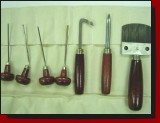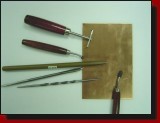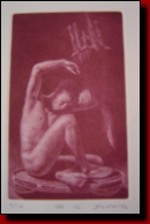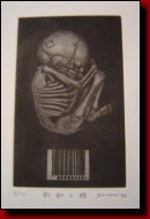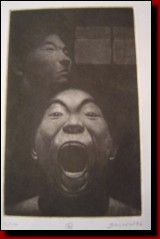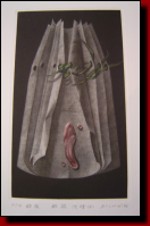Intaglio
Intaglio means cutting in Italian. The correct meaning is the ink part in the cutting section. The theory is to sketch pictures on the surfaces of the selected plates by etching or cutting. Then add ink into the hollow section and wipe the rest ink from the parts that are not cut or etched. . Next, press a piece of paper against the plate so that the paper can sink into the hollow section completely. The work with this kind of procedure is called intaglio.
Materials
In the early time, the material of intaglio is mostly copper. Therefore, intaglio is often called copperplate etching. Nowadays, many kinds of materials can be used in intaglio. Besides copper, zinc, iron, tin, alloy, etc. are adopted by many people. Some nonmetals like acrylic resin or thick cardboard are also used.
Original
In the early 15 century, an Italian craftsman put ink in the hollow sections of the decorative designs on swords, handles, and helmets to show the designs clearly. Then, some melted wax covered the designs occasionally. After the wax was congealed, people took the wax out and found the decorative designs were on the wax with ink clearly.
That inspired people. People began to sketch pictures on the copperplates with the way they used on the decorative designs on swords, handles, and helmets. They added ink into the hollow sections and wiped the rest ink from the parts that were not cut. . Finally, they pressed paper against the plates to get the whole pictures. That is the original concept of intaglio.
Characteristics
1. The ink is attached to the deep hollow section more than to the shallow part. Therefore the different depths of the hollow sections on the same plate make different effects.
2. The skills of intaglio are excellent in depicting tiny lines. Thus, it can bring delicate and sharp feelings to people.
3. The free lines and the harmony of dark and light colors can depict the complex human nature and the feelings delicately.
The Main Body of Performance
Lines are the main body of performance in the intaglio area.
Techniques:
Intaglio can be divided into two parts- chemical techniques and non-chemical techniques. Designing with chisels and gravers on the plates is the kind of non-chemical technique. Making by etching and eroding is called chemical technique.
The following is several techniques of intaglio.
Engraving
A graver is used to engrave the metal plate. The lines made with the graver on the surface of the plate will show the clear and sharp appearance.
Etching
An artist covers the surface of the metal plate with wax firstly. Then he designs on the plate and exposes the metal lines he depicts to the air. Next, he puts the metal plate in a acid trough. The metal lines are etched in the chemical acid liquid. Finally, when he wants to print the picture, he only has to remove the wax and uses some basic printing techniques to produce the unique characteristic - relief.
Dry point
An artist uses the sharp tools like gravers and chisels to depict on the plate directly. Therefore the lines are shallower than the ones by etching.
Mezzotint
The most special part of this technique is that its colors can range from gray to dark.
Tools
Gravers, plywood, dyestuffs, glues, papers, etc.
Methods
1. Clean the surface of the metal plate and rub the rim of the plate.
2. Cover the plate with preservative
3. Engrave pictures on the surface after the preservative get dry. Then, remove the preservative of the engraved lines and expose the metal lines to the air.
4. Put the plate into the acid trough and etch the lines exposed.
5. Wash the plate with water after taking it out.
6. Remove the rest preservative.
7. Apply ink to the hollow sections with bandages and wipe the rest ink outside the hollow sections.
8. Moisturize a piece of paper to increase the tenacity.
9. Put the plate on the printing machine.
10. Add a piece of paper and then cover it with a felt.
11. Operate the machine.
12. Sign the author’s name and the number of edition after completing the work.
13. A work of intaglio is completed.
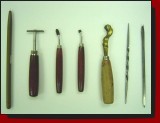
tools for Intaglio(1) tools
for Intaglio(2) tools
for Intaglio(3) tools
for Intaglio(4)
Intaglio
work: newborn
Intaglio
work: molt
Intaglio:
new generation
Intaglio:
roar
track-
sleep deeply
time-flying 